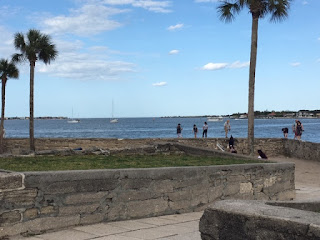We're moored at St. Augustine. "Moored" means that we have tied onto a mooring ball that is anchored by the marina. We're not docked. To get to shore, we can either take our dinghy to shore and tie onto a "dinghy dock" (a designated dock for dinghies) or schedule to be picked up by a marina boat (they pick up every 2 hours on the even hours, starting and ending at 6 am/pm). Mooring works like this: If we anchor out, it's free and we're on our own (like back-backing in the Cascades). If we dock in a slip at a marina, it's like staying at a hotel with all the amenities within easy reach. If we moor, it's like staying at a campground (amenities are within walking, er....dinghy distance).
This morning, we left the very new and attractive area of Palm Coast. We docked at the municipal marina last night to wash down Velsignet (she was covered in salt), fuel up, pump out, do laundry and get groceries (We used the "Instacart" app to have groceries delivered from the nearby Publix Grocery store; it was great!). In addition, we enjoyed an Italian meal out with Minnesotan Loopers Mike and Sharon (MV "Jealous Mistress") at the nearby "European Village." Apparently, Palm Coast is a new city; it was developed/created in the late 1980s. It doesn't really have a downtown. Rather, it's developed for (probably) the retirees...lots of attractive housing, bike trails, parks, etc. There are "shopping centers," but no "downtown." It was very nice. We could've spent an extra day exploring on the many bike trails it offered.
We arrived at St. Augustine this afternoon and moored at site 16 at the Augustine Municipal Marina. St. Augustine is the oldest city in North America and has a historic downtown with plenty of placards to educate those visiting. Being Sunday, we chose to walk around to get a feel for the area. For the next day or two we hope to visit and learn more about this fascinating city by which its heritage is founded by the Spanish, relinquished to the English, and won by the Americans. Already we've visited sites whereby trade routes were protected, a central park was dictated, the first Catholic church was instituted, slaves were traded, and the civil rights movement was tackled.
 |
| Velsignet was following this sailboat wondering "is this tall boat going to make it under the bridge?" |
 |
| As we got closer to the bridge, we were amazed at how this tall sailboat was able to make it without any trouble. |
 |
| This is the Bridge of Lions in St. Augustine. Two lions made of marble guard the bridge on the old town St. Augustine side. Construction of the bridge began in 1925 and was completed in 1927. From its earliest days, it was hailed "The Most Beautiful Bridge in Dixie" and has long been a symbol of our nation's oldest city. |
 |
This is the Pirate Ship that visitors can take to tour the Matanza Bay.
(To make sure we're not raided by Pirates, we lock our doors each night!) |
 |
In our nation's first public park is this statue of Ponce de Leon, the founder of Florida.
The statue is life-size of the 4'11" explorer! |
 |
| Buildings such as the Governor's House date back to the 1600's. Built by the Spanish, visited by the Spanish, and preserved by the Americans! |
 |
| Off of St. George Street, we found this brave young man sporting...braving... a couple of snakes. |
 |
| This is Mike in front of the Castillo de San Marcos, the oldest and largest masonry fort in the continental United States. |
 |
| This picture is taken from the Castillo de San Marcos to the east towards the Atlantic Ocean. The Spanish were not only able to protect St. Augustine from the fort, but those ships from enemy nations traveling the Gulf stream to access the "New World" lands. |
 |
| We found this wonderful place to enjoy a light dinner in St. Augustine. We sat outside under the trees and listened to a gifted acoustic guitar player as we enjoyed a bottle of petite wine with a cheese and meat tray. |
 |
| We took this picture to help us re-create a cheese and meat tray for ourselves someday. The photo doesn't adequately reflect how attractive it looked and delicious it tasted! |












Comments
Post a Comment
We would love to hear your comments!